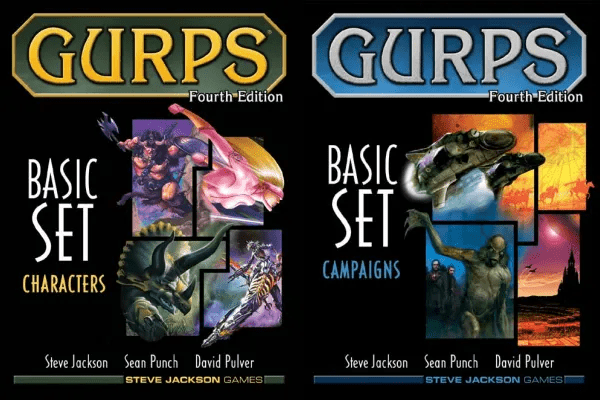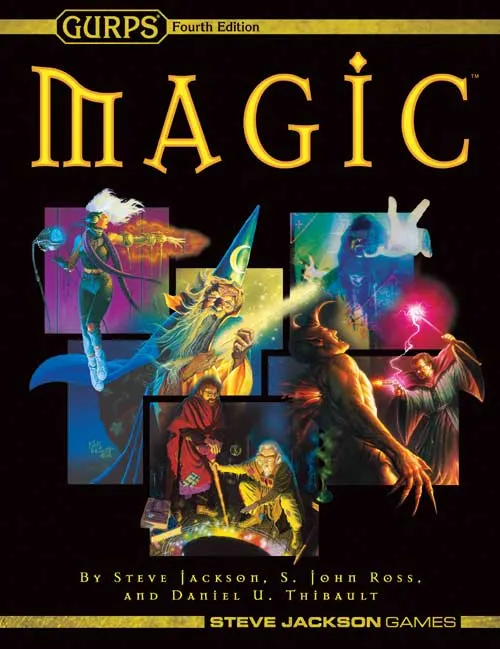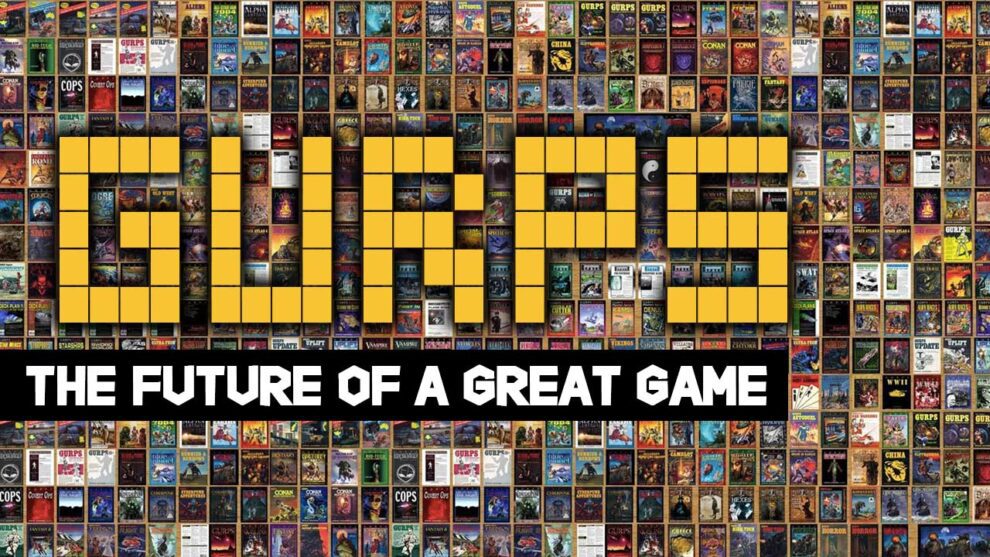
The GURPS Inception
In 1986, Steve Jackson Games released a role playing game that was different from anything that had been released prior. GURPS was designed to be a game system that transcended genre. Where there existed fantasy, sci-fi, horror, and even superhero role playing games. GURPS went in the direction of being all of those and more. 1986 saw both the 1st and 2nd editions of the system released as boxed sets.
GURPS, which is an acronym meaning Generic Universal Role Playing System, accomplishes the task of being all genres by defining characters in terms of traits. There are no classes or professions that define a character and set them on a predetermined path of traits (i.e., skills and abilities). Instead, players are able to select what traits they want when the character is created. As they advance, they can improve the traits they already have, or take on new traits. These are all purchased with character points. GURPS traits come in five basic flavors: attributes, advantages, disadvantages, quirks, and skills.
GURPS 3rd Edition was released two years later, in 1988. This became the definitive edition of the game for many years. The rules were extensively cross-referenced and well written. Supplements were released like clockwork: over the years, more than 250 source books would be written for this edition of the game. Although it never cracked into the top three for RPG sales, GURPS 3rd Edition became—and remains—one of the most successful lines of roleplaying material ever published.
GURPS 3rd Edition was stable. The core rules, called the Basic Set, contained a fixed set of advantages, disadvantages, and skills. Over the course of 250+ books, many elements had been created that were essentially generic universal traits; since the page references involved in the extensive cross-referencing could not be mucked with, a GURPS 3rd Edition Revised core rulebook was produced. This book left all of the material in the front of the book alone. In the very back, in a 32-page area that originally held a sample fantasy adventure, a mini-supplement of material they wished could be in the core was included. But this was far from extensive.
Enter Sean “Dr. Kromm” Punch. Taking over as GURPS Line Editor in 1995 (and who over the years has become the face of GURPS) created a two-volume set of books in 1996 called GURPS Compendium I and GURPS Compendium II. Together, these books included everything that would have been in the core book had it been possible to expand it without breaking down all of the indexing of the system. This was (to borrow a term) GURPS 3.5. These two books gave GURPS 3rd Edition a new lease on life.
Sometime in either 2002 or 2003 (depending upon the source), Sean Punch and David Pulver were tasked with revising and updating GURPS to a new 4th edition. GURPS 3rd Edition was approaching 15 years of age; the sheer volume of material written for the system had created a level of cruft — piled on specialized subsystems — which detracted from the streamlined beauty of the game. In 2004, GURPS 4th Edition was launched. Steve Jackson announced that the system would be extensively supported with premium products.
This fell apart rather quickly.
What follows is what happened from my point of view (I was there, I was involved in several playtests and was active on the message boards). Others may see those times and events differently. That said, this article is as honest and objective as I can report.
There are things that I was able to see online dealing with the various events I write about in this article that, due to changes in the structure of the Steve Jackson Games website, are no longer available. When I started working on this article years ago, I had access to those pages. Now, however, they are gone. Anytime I write about those elements of this saga, I will put the tag [NLA] at the end, meaning no longer available.

The Road to Hell…
Steve Jackson Games officially announced the (upcoming) release of GURPS 4th Edition on 16 March 2004 on their blog, the Daily Illuminator. The books were to be released in August of that year with an aggressive release schedule through the end of the year. A web-chat took place to answer questions.
In this chat, they confirmed that GURPS would have a very aggressive release schedule; the books would all be long-format, full-color, hardcover books—what I will call premium books.
These points are important to many fans of the system. Steve Jackson—the man and his company—were promising to bring premium production to their already premium content. If the fans were to be enticed to come over to the new system, as opposed to using the 3rd edition with whatever house rules they had developed over the years, they would need:
- Support: this meant releasing books for the new system, in the new premium format, to replace the extensive libraries most hard-core fans had acquired over the years.
- Something Extra: this meant something to make rebuilding their library worthwhile.
An aggressive release schedule handled support; premium books were unusual for Steve Jackson Games. It seemed to be an enticing carrot, the ‘something extra’ that could bring the old-guard over.
The first signs of cracks in the plan took place before month’s end. On 26 March, ten days after the official announcement, a contest for designing the GURPS Basic Set covers was begun. The original so-called gorgeous artwork was almost universally regarded as anything but gorgeous. Since this is entirely an aesthetic issue, the good folks at Steve Jackson Games took this in stride and asked their fan base: can you do better? The answer was yes. The first hurdle was cleared with ease. The finalists and the original artwork were posted online….[NLA]
As the weeks slowly passed, Daily Illuminator announcements directed GURPS fans to chats discussing changes in the GURPS skill system, how things would get consolidated and streamlined, etc. All appeared to be going well. In fact, for all intent and purpose, it was. Announcements for the new system included:
- GURPS Basic Set in both deluxe and the standard print went to press on time and were released in August.
- GURPS Dragons shipped in June, becoming the first GURPS 4th Edition book to hit the shelves. Since this was released prior to the Basic Set, it was written as a hybrid, capable of easily being used with either the 3rd Edition or 4th Edition of the game.
- GURPS Lite, a PDF and free print release of the core rules distilled into 32 pages was released in July.
- GURPS Update, a document for all 3e → 4e conversions, was released shortly after the Basic Set.
- GURPS GM’s Screen was announced for September 2004 when 4th Edition was announced.
- GURPS Fantasy was announced for October 2004 when 4th Edition was announced.
- GURPS Magic was announced for November 2004 when 4th Edition was announced.
- GURPS Infinite Worlds (a time-travel, dimensional-hopping campaign setting) was announced for December 2004 when 4th Edition was announced.
- GURPS Banestorm had its play test announcement on 22 August.
- GURPS Bestiary had its play test announcement on 22 August.
- GURPS Interstellar Wars (a new line for Traveller) was announced on 15 October.
- GURPS Powers (a book for dealing with super-powered beings) was announced on 21 November.
- And so on…
The aggression of the schedule was not in question. The ability for Steve Jackson Games to deliver on this schedule most certainly was. But more importantly, the ability for Steve Jackson Games to deliver premium production values was being tested early on.
The standard and deluxe printings of the GURPS Basic Set were a success. The original covers with the sub-standard artwork and flat, bland look were gone and replaced with the puzzle-look that had won the covers contest. These were seen as a great step forward and resulted in beautiful books. GURPS Dragons was a beautiful hardcover book (that was a hybrid product and did not use the new 4e cover style) with full-color art and set the standard for GURPS supplements. This book was considered a universal success.
GURPS Lite was seen as an odd booklet. The choices for advantages and skills to include in the trimmed list was suspect (e.g., Jumper), causing some to call into question the editorial choices. Given that this was a PDF and free-print product, it was given some slack. In the end, it was considered a success.
GURPS Update—another PDF release—was considered by many to be too long. This was exacerbated by the fact that the initial announcement and follow-up web chats indicated that virtually no conversion would be needed. Explanations were offered indicating that the document focused mostly on adjusting the point values of characters rather than adjusting capability. Response to this was mixed. It is about this time that some of the old-guard GURPS fans were starting to question the new edition. Comments and conversations on the message boards were plentiful.
The first product to be seen as an objective failure was the GURPS GM’s Screen. For a line that was touting itself as premium production, this fell flat. It was thin and flimsy; it had the artwork that was rejected for the original covers. In an online poll, 93% voted against the art they used in this product.[NLA]
GURPS Fantasy, GURPS Magic, and GURPS Infinite Worlds were all released on time. GURPS Fantasy was seen as a good, fresh look at the genre with few missteps. GURPS Infinite Worlds was an interesting compilation of alternate worlds and the campaign from GURPS 3e’s Time Travel.
GURPS Magic, on the other hand…

GURPS Magic—Fail
When GURPS Magic hit the shelves, a lot of people were shocked to find that the system was not updated, fixed, corrected, or… well, anything. The issues that had been well documented were not corrected. The optional systems, those things that make GURPS the flexible tool-kit that it is, were left out completely.
Back when the GURPS Basic Set was released, the short chapter on magic (~20 pages) was excused as something it needed to include in order to be truly generic and universal. GURPS Magic, it was said, is where multiple systems and flavors of magic would be discussed and fleshed out. Left unsaid was the fact that the baseline system presented in the Basic Set was the same system that lacked flavor and feel from the older editions, the system so many GURPS fans abandoned and created house rules for—the same system that was abandoned by many GURPS settings and articles dealing with magic (GURPS Voodoo, Unlimited Mana, etc.).
The flaws of the Basic Set rules were discussed at length following GURPS Magic‘s release. One of the biggest questions became: why did GURPS 4th Edition create a universal talent system for skills if Magical Aptitude (the original GURPS talent) was not going to use those rules? That question remained unanswered. It made no sense.
Magic suffered not only from creative lapses, but editorial lapses as well. A series of charts in the book detailing the steps needed to reach a particular spell included calculations indicating how many spells were prerequisites for a given spell. This chart was intended to allow a Game Master to move a spell without making it too easy or too hard to obtain. The problem: a large chunk of the calculations were wrong, sometimes by significant margins.
The discussions for GURPS Magic and how this book was a failure continued for some time. Then, Steve Jackson Games announced GURPS Thaumatology. This book is the one they would include alternative magical systems and corrections for GURPS Magic. Thus, GURPS Magic, only the third supplement for GURPS 4th Edition, would cause Steve Jackson Games to announce GURPS Thaumatology, a book with the singular goal of erasing the shortcomings of GURPS Magic from our collective memory.
GURPS Bestiary Disappears
GURPS Bestiary was announced while the GURPS Basic Set was just being released. In December, four months later, the play test seemed to be having trouble. The Basic Set sold out of its initial print run, so the system was doing well (even though the GURPS Online project was canceled about this time).
The Basic Set devotes one-third of the space to animals as it does to magic. The 3rd Edition book GURPS Bestiary was a relatively popular book. It went through multiple printings and revisions, it spawned several side-books (GURPS Space Bestiary, GURPS Fantasy Bestiary, GURPS Creatures of the Night, GURPS Dragons, etc.). Many, myself included, felt that a role playing system without a good manual of monsters is incomplete.
What was promised was a book that gave stats for real-world creatures, and rules for how to create interesting monsters, variations, and such, all while keeping in mind the creature’s role in its ecology and environment. What we got was nothing. In the two decades since GURPS 4th Edition was released, no proper handling of real-world animals, no GURPS Bestiary, has been produced. This was the first of many realizations that GURPS was not going to live up to the promise. If you ask the GURPS loyal, they will tell you that many PDF products have come out that fill this void.
However, I respectfully disagree. What we received was various files that contained creatures and monsters, but nothing that gave guidance on what ecological niche those creatures filled or how their various traits reflect that role. We received plenty of monsters, but we never got a book about how to create them, how to make them make sense, or how to build an environment that makes sense.
Did We Say “Aggressive”?
It did not take long before books began to slip in the official schedule. The original aggressive schedule was supposed to be one premium book per quarter, plus the three books that were scheduled to be produced in the last quarter of 2004 (i.e., GURPS Fantasy, GURPS Magic, and GURPS Infinite Worlds). Had this schedule been kept, Steve Jackson Games would have approximately 80 premium books in the GURPS 4th Edition library as of this writing. If you go to Warehouse 23, the Steve Jackson Games web store, there are exactly five physical items for GURPS 4th Edition available. Going to Amazon, you can find about fifty titles available for GURPS 4th Edition, but the vast majority of those are released via the GURPS On Demand project as print on demand paperbacks, not premium books.
The primary support system for GURPS ceased being books a long time ago. Instead, it became the third iteration of Pyramid Magazine, a PDF publication that handled things in relatively short articles. Then, even that avenue was shut down in December of 2018. When a premium book was produced, it generally received a single print run and would not see print again until the GURPS On Demand project got into full swing. Some never reached this point, and can only be found in PDF form these days.
If you total the number of premium books, non-premium books, short-form PDF releases, and Pyramid Magazine issues, there have been nearly 400 GURPS 4th Edition releases over the past two decades. This comes out to approximately one product every 18-20 days. This is an impressive amount of output, but it is not what was promised. Most of these are so small as to not even be close to the amount of information contained in the smallest (64 page) books released in the GURPS 3rd Edition era.
Oh, and trying to cross-reference this mess has become a bigger nightmare than GURPS 3rd Edition ever was.
What Happened?
After the fiasco with GURPS Magic, GURPS Bestiary, and several other planned books, the support for GURPS 4th Edition was pushed down to a less premium level. The fact is that far more of Steve Jackson Games’ cash flow is derived from the card game Munchkin than from any other product.
Not long ago, Steve Jackson was able to regain rights to his earliest attempt at a role playing game, The Fantasy Trip. To be honest, this was the prototype series of games (i.e., Wizard, Melee, etc.) that were the inspiration for Man-to-Man and GURPS. The Fantasy Trip seems to get more printed support than GURPS these days. GURPS support has been pushed aside for shorter-cycle venues.
The point is that GURPS is not the main focus of Steve Jackson Games. It once was, but it has not been for some time and it will not be in the foreseeable future. Role playing games are a sideline business for the company as Munchkin takes over the vast majority of their resources. Which makes sense: this is their big money maker.
Steve Jackson is a man who wants to do some things simply because he wants to do them. This can be a good thing! Thanks to this sort of drive, a Kickstarter campaign raised nearly one million dollars to revive the OGRE line! You cannot argue with success like that. But he is just one man, and Steve Jackson Games has limited resources. When Munchkin takes up most of the time, and other projects eat into what it left, things like GURPS fall to the sidelines. Again, none of this is to say they are wrong. Steve Jackson Games is a business. Like any other business, they look at their market and adjust accordingly. But as a GURPS fan, this makes me sad. So let’s look at what I think needs to happen.
What Needs to Happen?
First, we need to establish some assumptions (so let us recap some points from above):
- GURPS is, at its core, one of the most robust roleplaying systems ever written.
- GURPS 3rd Edition suffered from a decade of cruft piling on top of the core engine.
- GURPS Compendium I and GURPS Compendium II spared GURPS the need to go to a 4th Edition for several years.
- GURPS 4th Edition had lofty goals, and fell flat on some. A few missteps were caused by having goals that were unattainable or unsustainable (depending upon whom you ask); others were caused by internal editorial and design choices.
- GURPS 4th Edition is not getting the support and attention it needs thanks to a company that needs to focus on its largest money-maker.
All of this said, I think it is time for Steve Jackson to either sell GURPS to another company, or create a spin-off, which can treat GURPS as its primary focus. Role playing is far from dead! Pathfinder is doing well; Dungeons & Dragons 5th Edition is doing well; Mutants and Masterminds; Dragon Age; Edge of the Empire; 13th Age and many, many other RPGs are doing well. A smaller, more agile company with GURPS as its primary focus could do well for itself.
Assuming this were to happen, a 5th Edition should be created. The core set should have:
- a Characters book
- a Campaigns book
- a Creatures book
This is not meant to suggest that this is the only combination that works. But having a book dedicated to the core rules and character creation, another dedicated to the Game Master and how to create and run campaigns, and a third to explain how creatures (whatever their type) works with guidance on how to create interesting monsters… yea, I think that is a winning combination.
The books should be 256+ page, greyscale books. GURPS is, and should always be, a premium content brand, not a premium production brand. Pretty pictures are useless if the content is not there. Excellent content is not made better with pretty pictures. Good, solid, black-and-white art is perfect for the style GURPS uses.
Primary subsystems (e.g., technological levels) should be handled in the most simple and basic manner. Books going into these concepts in detail should be planned and assigned as the 5th Edition is being put together.
Specialized subsystems (e.g., magic, powers) should be left out of the core books entirely. There are literally an infinite number of potential campaigns that have no magic in them; there are an equal number that have no super-powered beings. So plan and create these subsystems while the core is being written, but make them their own volumes.
When it comes to hardcover or softcover, that should be the customer’s choice. The entire line should be available as PDF files, and via a good print-on-demand service as either hardcover or softcover. Once a book is in print, it should remain that way forever.
Am I on to something? Am I off my rocker and have no idea what I am talking about? Let me know in the comments.











I thought the Dungeon Fantasy boxed set approach had merit. Consolidating all core rules for a particular genre really cut down on the clutter. It made the system approachable to those that might be intimidated by the more tool kit presentation of 4th edition. I think for Dungeon Fantasy to be a success, more boxed sets of other genres are needed. In my head, “3” is the magic number: Dungeon Fantasy, Space Station X, and maybe something modern day, like Boston PD Moonlight Project (monster hunters). Getting 3 starts the “collectors” vibe, which should help sales. People will buy them just to have all the sets. (I still have unopened boxes of Munchkin games).
That is an amazing idea! And one that had not occurred to me.
….and, as time goes by, people with the boxed set collections may eagerly buy the 4th edition books to handle genres not having their own boxes.
Yea… somebody needs to contact SJGames — this is an amazing idea.
If Steve Jackson hasn’t let the license for Traveller slip a Traveller Powered by GURPS box would be printable money.
No, I get what you’re aiming for, but I take a few exceptions.
-I honestly don’t think we’re at a 5th Edition right now. Unless there are a lot of innovations behind the curtain currently we’re still working with rules that came out close to 20 years ago. And that’s GOOD!. 4th edition pushed out while people were still running 3rd edition with very few changes and as a lot of players never bought 4th edition. The lesson to be learned is that a new edition should reflect more than just a handful of rule changes and a better layout. But there’s no reason why Steve Jackson Games shouldn’t publish a 4th Edition Revised with updates to content.
-I don’t think Steve Jackson games will let go of any of it’s property without going under. They hold the rights to a lot of dead paper and have manage to kickstart some of it into revenue. GURPS is actually a very big IP and still generates proffit. An independent company would need a LOT of money to convince them to sell GURPS. Any fix we want for GURPS has to be something we can manage within Steve Jackson games.
-I do agree that the 4th edition core books had a lot of loose content. But I don’t know how it could have been spared within the spirit of the concept of the core books being able to support all kinds of play. It really needs a magic section to support fantasy games out of the box. I think that may be one of the unattainable goals speaking but I think the great success of 4th edition is keeping all the rules in the core books. Prior editions of GURPS were a mess of hunting down where you read that thing that you need.
-I don’t think you can created a useful 256+ page Creatures Book. I could be wrong here but I feel like antagonists in GURPS is such a HUGE undertaking. It’s why 4th edition publishes so few templates even in their setting books. I think GMs would be better served by a book about creating antagonists that includes traits specific to antagonists. Maybe even some content about building better villains, antagonist organizations, etc.
-I really apprecaite the color in 4th edition. It’s a big book and it makes it a lot easier to navigate. Some art in the mix doesn’t hurt GURPs’s ability to sell itself. I do fully agree GURPS focus should be content over production, but some production is a necessity.
-I think Dungeon Fantasy box sets was a bigger success than Steve Jackson Games understands in terms of selling a product line paralell to GURPS that brought new blood into the game. It’s certainly provoked a lot of games online. I think future powered-by-GURPS projects are a smart investment in terms of shipping a complete game that’s accessable to new players even if they don’t sell a warehouse full of product.